

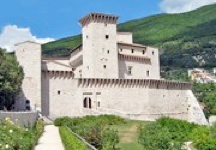
The name “Flea” (which rhymes with “player”) derives from the nearby River Feo (or Flebeo). The original nucleus seems to have been a ancient church that has been identified below the main tower, which might have been the documented Sant’ Angelo de Flea (below).
[The Counts of Nocera probably built the first fortress here towards the end of the 10th century]
Gualdo and its fortress passed to Perugia in 1208, and an attempt by Gubbio to dislodge the Perugians in 1216 failed.
The Emperor Frederick II effectively rebuilt the Rocca in 1247, and much of the present structure, dates to this period. [The Rocca conserves a number of elements from the 13th century structure: external arches; vaults; windows; portal of the Cappella di San Giovanni Battista; stairs to the loggia on the upper floor]
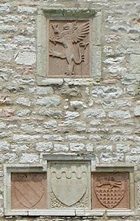
In the 15th century, the Rocca acted as the centre of operations of a succession of condottieri. In the 16th century, it became the residence of the papal legates, and was decorated with frescoes, some of which survive.
[Room of Cardinal Salviati with wooden ceiling (16th century); Wing of Cardinal Del Monte]
The fortress passed to the Commune in 1803 and was used as a prison for a period from 1888. It has been recently restored and houses the Museo Civico and the Pinacoteca Comunale.
Sant’ Angelo de Flea (10th century?)
As mentioned above, this ancient church probably formed the original nucleus of Rocca Flea. [Original window and fragments of original decoration uncovered during a recent restoration?] It was used as a chapel until 1544, when the Cappella di San Giovani Battista (below) was built. It was then used as the stables.
The church was restored in 1976 and is now part of the Pinacoteca Comunale.
Frescoes (14th century)
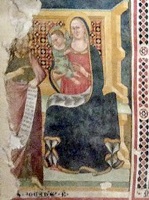
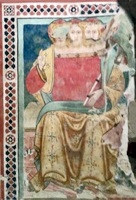
These frescoes to the right on the counter-facade, which were rediscovered in 1995, depict:
-
✴the Madonna and Child and St John the Baptist; and
-
✴the Trinity.
The second of these uses the iconography of “vultus trifons” (Tuscan dialect, meaning thre faces), which was banned from the 16th century. Traces of two earlier frescoes of the same subject can be identified below it.
Fresco Fragments (14th century)
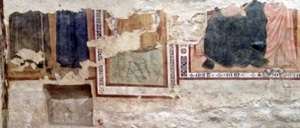
These fresco fragments on the right wall depict (from the left):
-
✴St Antony Abbot (identified by inscription) and another hermit saint;
-
✴St Christopher (identified by inscription), standing in the river across which he presumably carries the baby Jesus; and
-
✴the Madonna and Child enthroned with St John the Evangelist (identified by inscription).
Detached Frescoes (15th century)
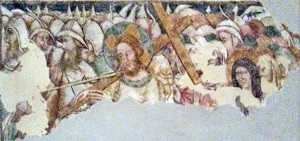
A number of detached fresco fragments that were detached from the walls in 1976 (thus revealing the earlier decoration) are exhibited in the ex-church. They seem to have depicted scenes from the life of Christ. The largest fragment (illustrated above) depicts Christ’s ascent to Calvary.
Cappella di San Giovanni Battista (1544)
Cardinal Giovanni Salviati , who was the papal legate in 1543-1553, built this chapel in the coutyard.
Art from the Chapel
Baptism of Christ (ca. 1544)
This panel from the chapel is attributed to Francesco de’ Rossi (who is known as Francesco Salviati because he enjoyed the patronage of Cardinal Giovanni Salviati). It entered the Pinacoteca Comunale in 1880.

